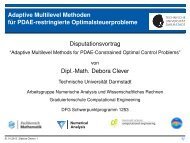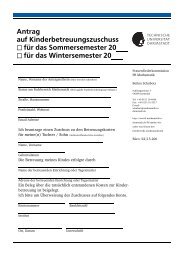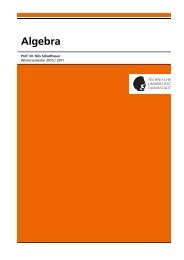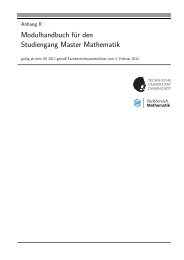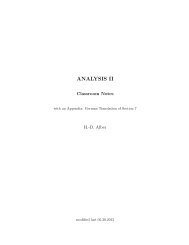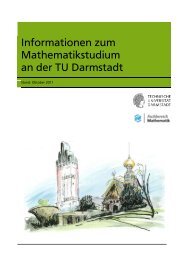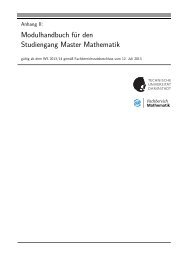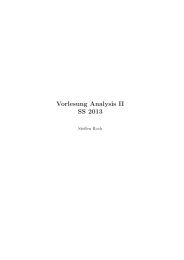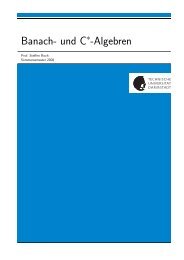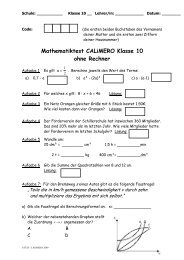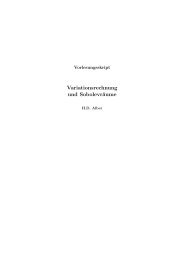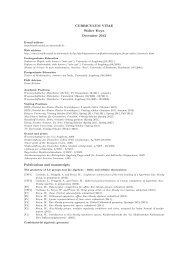PARITY OF THE COEFFICIENTS OF KLEIN'S j-FUNCTION 1 ...
PARITY OF THE COEFFICIENTS OF KLEIN'S j-FUNCTION 1 ...
PARITY OF THE COEFFICIENTS OF KLEIN'S j-FUNCTION 1 ...
You also want an ePaper? Increase the reach of your titles
YUMPU automatically turns print PDFs into web optimized ePapers that Google loves.
<strong>PARITY</strong> <strong>OF</strong> <strong>THE</strong> <strong>COEFFICIENTS</strong> <strong>OF</strong> KLEIN’S j-<strong>FUNCTION</strong>CLAUDIA ALFESAbstract. Klein’s j-function is one of the most fundamental modular functionsin number theory. However, not much is known about the parity of its coefficients.It is believed that the odd coefficients are supported on “one half” of the arithmeticprogression n ≡ 7 (mod 8). Following a strategy first employed by Ono for thepartition function [9], we use twisted Borcherds products and results on the nilpotencyof the Hecke algebra to obtain new results on the distribution of parity forthe coefficients of j(z).1. Introduction and statement of resultsHere we consider the modular j-invariant(1.1)j(z) := E 4(z) 3∆(z) = (1 + 240 ∑ ) 3∞ n 3 q nn=1 1−q nq ∏ ∞n=1 (1 − qn ) 24 = q −1 + 744 + 196884q + 21493760q 2 · · · ,where q := e 2πiz and z ∈ H. Its properties and connections to number theory, ellipticcurves, class field theory and moonshine are well known.However, surprisingly little is known about the behavior of the coefficients of j(z)modulo a prime. Perhaps the most famous congruence is due to Lehner [5]. Forprimes p ≤ 11, he showed thatj(z)|U(p) ≡ 744(mod p),where j(z)|U(p) = ∑ ∞n=−1 c(n)qn/p and the summation is only carried out over n’s thatare divisible by p. Lehner [6], [7] and Kolberg [4] later expanded on such congruences.Serre [11] showed that congruences of the U(p)-type do not hold for primes p > 11.Ahlgren and Ono [1] generalized Lehner’s and Serre’s result to all weakly holomorphicmodular forms (see Theorems 2 and 4 of [1]).Here we address the parity of the coefficients of j(z) := ∑ ∞n=−1 c(n)qn . Since wehave E 4 (z) ≡ 1 (mod 2), (1.1) easily givesj(z) ≡1q ∏ ∞n=1 (1 − q8n ) ≡ 3 q−1 + q 7 + q 15 + q 31 + · · · (mod 2).The author thanks the support of the German Academic Exchange Service.1
3(1) 4∆ ′ 0l is a fundamental discriminant and ∆ ′ 0l ≡ 7 (mod 8).(2) l > 112 (12H(−16∆′ 0l) + 2) [Γ : Γ 0 (4∆ ′ 0)].Then there are infinitely many odd m for which c(∆ ′ 0lm 2 ) is even.Remark. For any fixed ∆ ′ 0 as above, all but finitely many primes l with ∆ ′ 0l ≡ 7(mod 8) satisfy the conditions in Theorem 1.4.To obtain these results, we consider the logarithmic derivatives of twisted Borcherdsproducts defined by Zagier [14]. We are then able to interpret the coefficients of j(z)as the coefficients of weight 2 meromorphic modular forms modulo 2. Employing astrategy of Ono [9] using results on nilpotency and the distribution of parity holdingfor modular forms of integer weight then yields our results.The paper is organized as follows. In Section 2 we present necessary backgroundinformation on Borcherds products and the nilpotency of the Hecke algebra. InSection 3 we prove the results about the coefficients of j(z).AcknowledgementsThe author thanks Ken Ono for valuable discussions and his guidance throughoutthe project. Moreover, the author thanks Stephan Ehlen, Marie Jameson, and RobertLemke Oliver for helpful discussions and comments.2. Borcherds products and modular forms modulo 22.1. A twisted Borcherds product. In [14] Zagier considers the traces of the modularj-invariant. He shows that they are connected to certain basis elements of thespace of weakly holomorphic modular forms of weight 1/2 on Γ 0 (4) satisfying theKohnen plus space condition. More explicitly, for every negative discriminant −d,there is a unique (and easily constructable) f d in that space, whose Fourier expansionat the cusp ∞ is given by(2.1) f d (z) = q −d + ∑ n≥1n≡0,1(4)c d (n)q n .The f d ’s form a basis of this space. In particular, f 4 is given by(2.2) f 4 (z) = f 0 (z) · j(4z) − 746 · f 0 (z) − 2 · f 3 (z),where f 0 (z) := θ(z) = ∑ n∈Z qn2 is the ordinary Jacobi theta series.As before we let ∆ be a positive fundamental discriminant which is congruent to 0modulo 4.We then define the function(2.3) P ∆ (X) := ∏(1 − e 2πib/∆ X) ( ∆ b ) ,b (mod ∆)
4 CLAUDIA ALFESwhere ( )∆b denotes the Kronecker symbol. Then the statement Theorem 7 of [14]reads as follows (see also Section 8.1 of [2]).Theorem 2.1. The twisted Borcherds product∞∏Ψ ∆ (z, f d ) := P ∆ (q m ) c d(∆m 2 )m=1is a meromorphic modular form of weight 0 for the group SL 2 (Z) whose divisor onX(1) is supported on CM points of discriminant −∆d.Using this result we can easily obtain Theorem 1.1.Proof of Theorem 1.1. We let Θ := q d dq . Then Θ(Ψ ∆(z, f d )) is a weight 2 meromorphicmodular form on Γ. Therefore, the logarithmic derivative Θ(Ψ ∆(z,f d ))Ψ ∆ (z,f dis a weight)2 meromorphic modular form on Γ whose poles are simple and are supported at theΓ-CM points of discriminant −∆d.Using (2.3) it is not hard to show thatΘ(P ∆ (q m ))P ∆ (q m )= − √ ∆m∞∑n=1( ∆n)q nm .We now let d = 4. For the logarithmic derivative of Ψ ∆ (z) we obtain(2.4) F(∆; z) := −√ 1 Θ(Ψ ∆ (z))∞∑∞∑( ) ∆= mc 4 (∆m 2 ) q nm .∆ Ψ ∆ (z)nSince, by (2.2), f 4 (z) ≡ j(4z) (mod 2) we have that c 4 (4m) ≡ c(m) (mod 2), whichimpliesc 4 (∆m 2 ) ≡ c(∆ ′ m 2 ) (mod 2).m=1Combined with the fact that ( )∆n = 0 if gcd(n, ∆) ≠ 1, we obtain∞∑∞∑F(∆; z) ≡ c(∆ ′ m 2 ) q nm (mod 2).m=1gcd(m,2)=1n=1gcd(n,∆)=12.2. Local nilpotency and the distribution of odd coefficients. Here we recallseveral results about the nilpotency of the Hecke algebra on modular forms modulo2 and the distribution of odd coefficients. All of these can be found in [8] and [9].Let f(z) be an integer weight modular form on Γ 0 (N) with integer coefficients. Iff(z) ≢ 0 (mod 2), then we say that f(z) has degree of nilpotency i if there are primesp 1 , p 2 , . . . , p i−1 not dividing 2N for whichn=1f(z) | T p1 | T p2 | · · · | T pi−1 ≢ 0 (mod 2),□
and if for every set of primes l 1 , l 2 , . . . l i not dividing 2N we havef(z) | T l1 | T l2 | · · · | T li ≡ 0 (mod 2).It is known that the action of Hecke algebras on spaces of modular forms withinteger coefficients is locally nilpotent modulo 2. In particular, this result was provenby Tate [13] for modular forms of integer weight on SL 2 (Z). His result was latergeneralized by Ono and Taguchi [10]. Moreover, Ono proved the following results.Lemma 2.2 (Lemma 3.2 of [9]). Suppose that f(z) = ∑ ∞n=1 a(n)qn ∈ S k (Γ 0 (N) withinteger coefficients has degree of nilpotency i > 0. Then the following are true:(1) There are primes p 1 , p 2 , . . . , p i−1 not dividing 2N, and an integer n 0 such thata(n 0 M 2 p 1 p 2 · · · p i−1 ) ≡ 1 (mod 2)for every integer M ≥ 1 that is coprime to 2p 1 p 2 · · · p i−1 N.(2) If l 1 , l 2 , . . . l i are primes not dividing 2N, thenfor every n coprime to l 1 , l 2 , . . . l i .a(nl 1 l 2 · · · l i ) ≡ 0 (mod 2)Theorem 2.3 (Theorem 3.3 of [9]). If f(z) = ∑ ∞n=1 a(n)qn ∈ S k (Γ 0 (N)) has integercoefficients, then the following are true:(1) A positive proportion of the primes p ≡ −1 (mod 2N) have the property thatf(z)| T p ≡ 0 (mod 2).(2) Suppose that n 0 is an integer coprime to N with the property thata(n 0 p 1 p 2 · · · p i−1 ) ≡ 1 (mod 2),where p 1 , p 2 , . . . , p i−1 are primes which do not divide 2n 0 N. If M is an integercoprime to 2N and gcd(r, M) = 1, then# {m ≤ X : a(n 0 m) ≡ 1 (mod 2) and m ≡ r (mod M)} ≫ Xlog X (log log X)i−2 .3. Proof of Theorems 1.2, 1.3, and 1.4Here we prove Theorems 1.2, 1.3, and 1.4 where we argue analogously to Ono in[9].We let H D (X) be the usual discriminant −D Hilbert class polynomial.Lemma 3.1. There is a holomorphic modular form of weight 12H(−4∆) + 2 on Γwith integer coefficients which is congruent to˜J(∆; z)H 4∆ (j(z))∆(z) H(−4∆) (mod 2).5
6 CLAUDIA ALFESProof. Let F(∆; z) be as in (2.4). Then F(∆; z) is a meromorphic modular form withinteger coefficients which is congruent to ˜J(∆; z) modulo 2. Moreover, its poles aresimple and are supported on SL 2 (Z)-CM points of discriminant −4∆. Since H 4∆ (j(z))has a zero of the same order at each such CM point and ∆(z) H(−4∆) accounts for thepoles at ∞ introduced by H 4∆ (j(z)), the claim follows.□Proof of Theorem 1.3. We first prove (1). Assume that all c(∆ ′ m 2 ) for odd m areodd, which implies∑ ∞ ∞∑(3.1) ˜J(∆; z) ≡ q mn (mod 2).We also have the classical identityΩ(z) := η(4z)8η(2z) 4 =m=1 n=1gcd(m,2)=1 gcd(n,∆)=1∞∑n=1 2∤d|ngcd(n,2)=1∑dq n = q + 4q 3 + 6q 5 + · · · ,where η(z) := q ∏ 1/24 ∞n=1 (1 − qn ) is Dedekind’s eta-function. It is well known thatΩ(z) is a modular form of weight 2 for Γ 0 (4). It obviously satisfies∞∑ ∞∑Ω(z) ≡q mn (mod 2).Then it is easily seen that(3.2) Ω(∆; z) := ∑1≤δ|∆ ′gcd(2,δ)=1m=1 n=1gcd(m,2)=1 gcd(n,2)=1Ω(δz) ≡∞∑∞∑m=1 n=1gcd(m,2)=1 gcd(n,∆)=1q mn (mod 2).In particular, we have that ˜J(∆; z) ≡ Ω(∆; z) (mod 2). By combining the fact thatΩ(∆; z) is a modular form of weight 2 on Γ 0 (4∆ ′ ) with Lemma 3.1, it follows that˜J(∆; z)H 4∆ (j(z))∆(z) H(−4∆) ≡ Ω(∆; z)H 4∆ (j(z))∆(z) H(−4∆) (mod 2)in M 12H(−4∆)+2 (Γ 0 (4∆ ′ )). Sturm’s theorem [12] now implies that this holds if andonly if the first 12H(−4∆)+2 [Γ : Γ12 0 (4∆ ′ )] coefficients are congruent modulo 2. Thisproves the bound concerning the first (if any) even value.Now assume there are only finitely many odd m for which c(∆ ′ m 2 ) is even. Denotethese m by m 1 , m 2 , . . . , m s and let m 1 be the smallest of these numbers. Using (3.2)we see that(3.3) Ω(∆; z) − ˜J(∆;s∑ ∞∑z) ≡q m in(mod 2).i=1n=1gcd(n,∆)=1
We now define T (∆; z) to be the level 1 cusp form∞∑(3.4) T (∆; z) := t(∆; n)q n := H 4∆ (j(z))∆(z) H(−4∆)+5 = q 5 + · · · .n=5Then the Hecke algebra acts locally nilpotently on T (∆; z) (see Section 2.2). Thedegree of nilpotency is an integer a ≥ 2 since the first coefficient of T (∆; z) is odd.Theorem 2.3 (2) now implies that in every arithmetic progression r (mod M), whereM is an odd integer coprime to r, that(3.5) # {p ≤ X : t(∆; p) ≡ 1 (mod 2) and p ≡ r (mod M)} ≫ X/ log X.Combining the properties of Ω(∆; z) and Lemma 3.1 yields the existence of a cuspform S(∆; z) on Γ 0 (4∆ ′ ) for which∞∑((3.6) S(∆; z) = s(∆; n)q n ≡ Ω(∆; z) − ˜J(∆;)z) T (∆; z) (mod 2).n=1For a positive integer N we find by using equation (3.4) thats∑ ∞∑(3.7) s(∆; N) ≡t(∆; N − m i n) (mod 2).i=1n=1gcd(n,∆)=1These sums are finite because t(∆; k) = 0 for k ≤ 5.Theorem 2.3 (1) implies that there are infinitely many primes p for which(3.8) s(∆; n) ≡ 0 (mod 2)when p || n. Let p 0 ∤ m 1 m 2 · · · m s ∆ be such a prime and let Y := p 2 0∆lcm(m 1 , . . . , m s ).Our construction of S(∆; z) together with (3.7) implies thats∑ ∑(3.9) s(∆; N + Y ) − s(∆; N) ≡t(∆; N + Y − m i n) (mod 2).i=11≤n≤ Y m igcd(n,∆)=1Using this we will construct a contradiction. Consider the arithmetic progression(3.10) N ≡ p 0 (mod p 2 0).For each pair (i, n), where 1 ≤ i ≤ s and 1 ≤ n ≤ Y m i, except (m 1 , 1) we considerprogressions of the form(3.11)N ≡ −(Y − m i n) + l 1 (i, n)l 2 (i, n) · · · l a (i, n) (mod l 1 (i, n) 2 l 2 (i, n) 2 · · · l a (i, n) 2 ).Choose distinct odd primes l j (i, n) which are coprime to p 0 m 1 · · · m s ∆ such that thesystem in (3.10) and (3.11) has a solution of the form N ≡ r 0 (mod M ∆ ), wheregcd(r 0 + Y − m 1 , M ∆ ) = 1. This solution exists by the Chinese Remainder Theorem.7
8 CLAUDIA ALFESBy (3.5) there are infinitely many primes p of the form N p + Y − m 1 for whicht(∆; N p + Y − m 1 ) ≡ 1 (mod 2). These p satisfy :(1) We have that p 0 || N p and p 0 || (N p + Y ) (because p 2 0 | Y ).(2) For each (i, n) with 1 ≤ i ≤ s and 1 ≤ n ≤ Y m i, except (m 1 , 1) we obtainN p + Y − m i n ≡ l 1 (i, n)l 2 (i, n) · · · l a (i, n) (mod l 1 (i, n) 2 l 2 (i, n) 2 · · · l a (i, n) 2 ).By (3.8) we now see that s(∆; N p + Y ) and s(∆; N p ) are both even. Lemma 2.2(2) implies that each summand in (3.9) is even, except t(∆; N p + Y − m 1 ), sinceT (∆; z) has degree of nilpotency a. But since t(∆; N p + Y − m 1 ) is odd, we obtainthe contradiction 0 ≡ 1 (mod 2) in (3.9). Therefore, there must be infinitely manyodd m with the property that c(∆ ′ m 2 ) is even unless there is no such m.To prove the second part of the theorem, observe that if c(∆ ′ m 2 ) is even for all oddm then ˜J(∆; z)H 4∆ (j(z))∆(z) H(−4∆) is trivial. Together, Lemma (3.1) and Sturm’sbound now imply the bound 1 (12H(−4∆) + 2) on the first m (if there are any).12Now suppose that ˜J(∆; z) ≢ 0 (mod 2) but only finitely many c(∆ ′ m 2 ) are odd.Then we see thats∑ ∞∑˜J(∆; z) ≡q m in(mod 2)i=1n=1gcd(∆ ′ ,n)=1and since this is the series in (3.3) the proof of the second part follows mutatismutandis by replacing (Ω(∆; z) − ˜J(∆; z))T (∆; z) with ˜J(∆; z)T (∆; z) in (3.6). □Proof of Theorem 1.4. Assume on the contrary that c(∆ ′ 0lm 2 ) is odd for every oddm. As before we see that(3.12) ˜J(∆0 l; z) ≡ Ω(∆ 0 l; z) = ∑Ω(δz) (mod 2)1≤δ|∆ ′ 0 lgcd(2,δ)=1where ∆ 0 = 4∆ ′ 0. The fact Ω(δz) is a holomorphic modular form of weight 2 onΓ 0 (4δ) together with Lemma 3.1 implies that⎛⎞∞∑a(n)q n := ⎜⎝ ˜J(∆ 0 l; z) −∑Ω(δz) ⎟⎠ H 4∆ 0 l(j(z))∆(z) H(−4∆ 0l)n=11≤δ|∆ ′ 0gcd(2,δ)=1is congruent to a weight 2 + 12H(−4∆ 0 l) holomorphic modular form on Γ 0 (4∆ ′ 0)modulo 2. Using (3.12) we see that∞∑∑a(n)q n ≡ H 4∆0 l(j(z))∆(z) H(−4∆ 0l)Ω(δlz) ≡ q l + · · · (mod 2).n=11≤δ|∆ ′ 0gcd(2,δ)=1
9This contradicts Sturm’s bound [12] for the first odd coefficient, which impliesl ≤ 1 12 (12H(−16∆′ 0l) + 2) [Γ : Γ 0 (4∆ ′ 0)] .Proof of Theorem 1.2. We let ∆ ′ 0 := 1 in Theorem 1.4. If l ≡ 7 (mod 8) is a primefor which(3.13) l > 6H(−16l) + 1then the claim follows from Theorem 1.4. Dirichlet’s class number formula impliesthat for the classical class numberh(−l) < 1 π√l log(l).Since here H(−16l) = 4h(−l) (see for example page 273 of [3]) (3.13) holds forall l ≥ 4023. The theorem follows from applying Theorem 1.3 (1) to each primel < 4023.□References[1] S. Ahlgren and K. Ono, Arithmetic of singular moduli and class polynomials, Compositio Mathematica,141 (2005), pages 293-312.[2] J. H. Bruinier and K. Ono, Heegner divisors, L-functions and harmonic weak Maass forms,Annals of Mathematics, 172 (2010), pages 2135-2181.[3] H. Cohen, Sums involving the values at negative integers of L-functions of quadratic characters,Math. Ann. 217 (1975), pages 271-285.[4] O. Kolberg, Congruences for the coefficients of the modular invariant j(τ), Math. Scand. 10(1962), pages 173-181.[5] J. Lehner, Divisibility properties of the Fourier coefficients of the modular invariant j(τ), Amer.J. Math. 71 (1949), pages 136-148.[6] J. Lehner, Divisibility properties of the Fourier coefficients of the modular invariant j(τ), Amer.J. Math. 71 (1949), pages 136-148.[7] J. Lehner, Further congruence properties of the Fourier coefficients of the modular invariantj(τ), Amer. J. Math. 71 (1949), pages 373-386.[8] K. Ono, The web of modularity: Arithmetic of the coefficients of modular forms and q-series,CBMS Conference Series, 102 (2004), Amer. Math. Soc.[9] K. Ono, The parity of the partition function, Advances in Mathematics, 225 (2010), pages349-366.[10] K. Ono and Y. Taguchi, 2-adic properties of certain modular forms and their applications toarithmetic functions, International Journal of Number Theory, 1, No. 1 2005, pages 75-101.[11] J.-P. Serre, Divisibilité de certaines fonctions arithmétiques, Enseignement Math. 22 (1976),pages 227-260.[12] J. Sturm, On the congruence of modular forms, Springer Lect. Notes in Math. 1240, Springer-Verlag, Berlin (1984), pages 275-280.[13] J. Tate, The non-existence of certain Galois extensions of Q unramified outside 2, Arithmeticgeometry (Tempe, AZ, 1993), Contemp. Math. 174, Amer. Math. Soc., Providence, RI, (1994),pages 153-156.□
10 CLAUDIA ALFES[14] D. Zagier, Traces of singular moduli, Motives, polylogarithms and Hodge theory, Part I Int.Press Lect. Ser., International Press (2002), pages 211-244.Fachbereich Mathematik, Technische Universität Darmstadt, Schloßgartenstr.7, D-64289 Darmstadt, GermanyE-mail address: alfes@mathematik.tu-darmstadt.de



